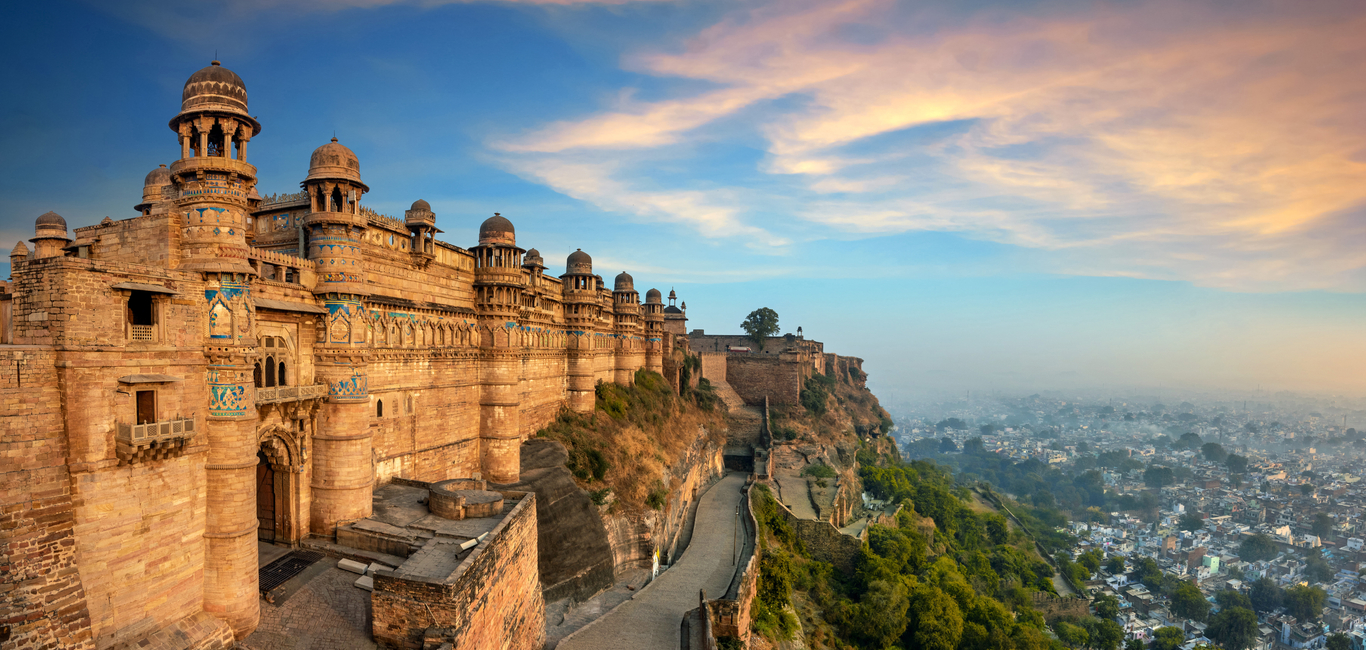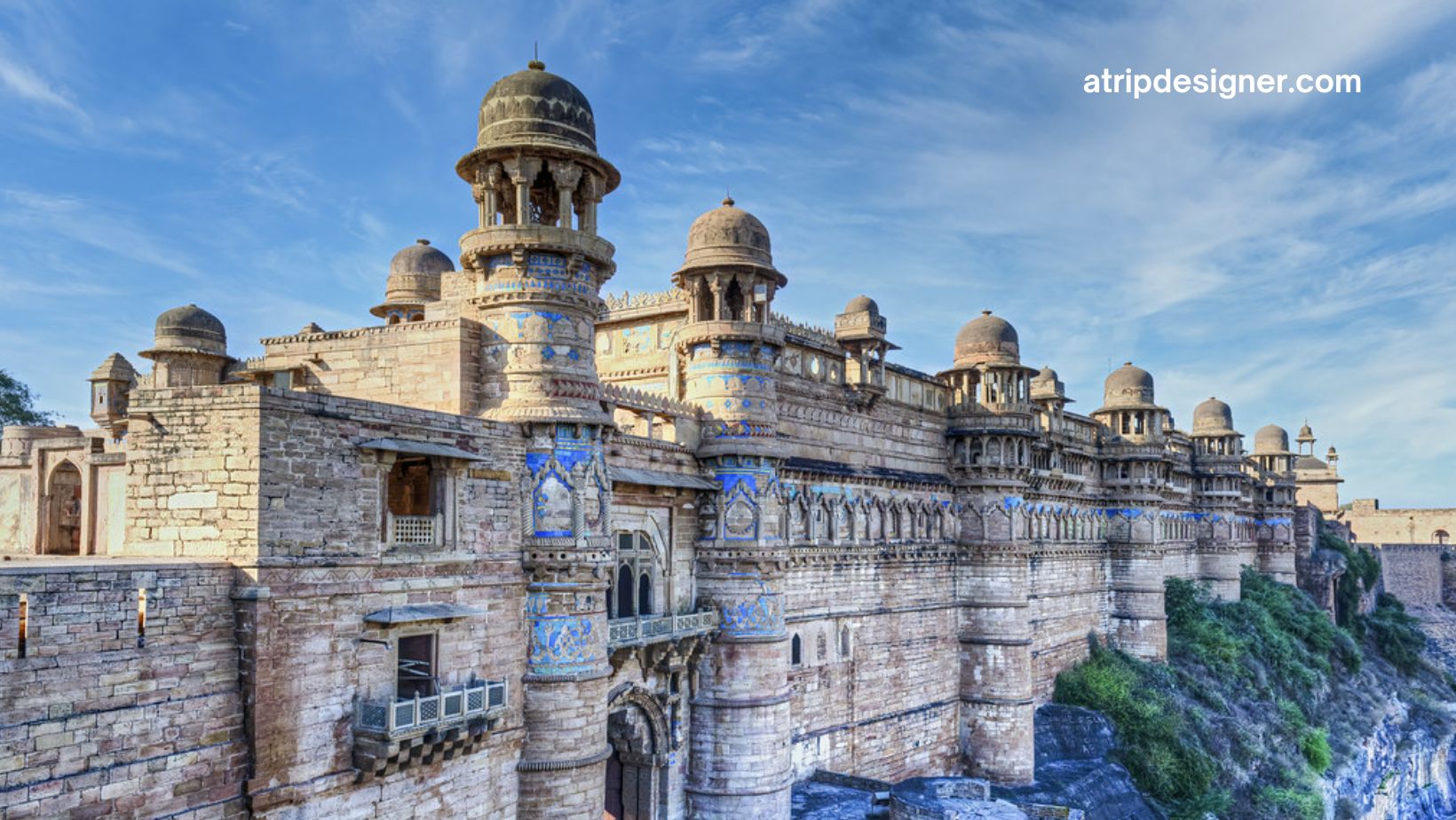Unlock the treasure trove of history and culture as we take you on a captivating journey to explore Gwalior Fort. Nestled in the heart of India, this ancient marvel beckons with tales of valor and echoes of a bygone era. Our guide will lead you through its imposing gates and labyrinthine pathways, revealing the secrets of its architecture and the legends etched into its walls. Dive deep into the vibrant history and rich cultural heritage of Gwalior Fort, where every stone has a story to tell.
Understanding the Magnificence of Gwalior Fort
Prior to commencing our journey of discovery, let us appreciate the magnificence of Gwalior Fort. This immense stronghold is situated atop a precipitous sandstone hill, commanding the Gwalior skyline within the Indian state of Madhya Pradesh. Encompassing approximately 3 square kilometers, the fort showcases a fusion of architectural motifs, mirroring the imprint of diverse dynasties that held sway over the region throughout the ages.
 Read more – Exploring the Enigmatic Havelis of Jaisalmer: Unveiling History and Culture
Read more – Exploring the Enigmatic Havelis of Jaisalmer: Unveiling History and Culture
The Entrance: Gateway to the Past
As you approach Gwalior Fort, you’ll first encounter the grand entrance, known as the Gwalior Gate or Badalgarh Gate. This gate serves as a preamble to the splendors within. The imposing structure, adorned with intricate carvings and chhatris (dome-shaped pavilions), gives you a glimpse of the artistic prowess of the era.
Exploring the Man Singh Palace
Once inside, make your way to the Man Singh Palace, a true gem of the fort. This stunning palace showcases a perfect blend of Rajput and Mughal architectural styles. The palace is adorned with vivid blue ceramic tiles, geometric patterns, and exquisite artwork. Don’t forget to look up at the intricately painted ceilings as you walk through its chambers, each whispering stories of its past inhabitants.
Read more – Unveiling the Mysteries of Raigad Fort, Maharashtra: A Historical Expedition
Saas Bahu Temple: An Architectural Marvel
While you explore the fort further, you’ll encounter the Saas Bahu Temple, showcasing the remarkable craftsmanship of the 9th century. Contrary to its name, which translates to “mother-in-law and daughter-in-law,” the temple’s devotion lies with Lord Vishnu. Marvel at the detailed carvings that narrate stories from Hindu mythology and admire the temple’s unique architecture, featuring two interconnected shrines.

Read more – Exploring Jaigarh Fort & Rich History and Cultural Activities
Teli ka Mandir: A Fusion of Styles
Another architectural masterpiece within the fort is the Teli ka Mandir, standing tall as a fusion of Dravidian and Indo-Aryan architectural styles. This 8th-century temple dedicated to Lord Vishnu is a visual delight, with its towering vimana (tower) and intricately carved sculptures.
Gujari Mahal: A Love Story in Stone
Gwalior Fort isn’t just about grandeur and history; it also resonates with poignant love stories. Gujari Mahal, within the fort’s complex, is a symbol of love between Raja Man Singh Tomar and his beloved queen, Mrignayani. This 15th-century palace is now a museum, housing sculptures, artifacts, and a glimpse into the royal past of Gwalior.
Read more – Exploring Lohagarh Fort: Unearthing the Rich History
The Jain Monuments: A Spiritual Retreat
Gwalior Fort is not just a testament to Hindu and Rajput history; it also bears the marks of Jain influence. The fort complex is home to several Jain monuments, including the magnificent Siddhachal Jain Temple. These serene shrines provide a spiritual contrast to the fort’s otherwise martial aura.
Scenic Views from the Fort Walls
While exploring the inner sanctums of the fort is a cultural and historical delight, don’t forget to take a moment to soak in the panoramic views from the fort walls. Gwalior Fort offers stunning vistas of the city below, with its bustling markets and modern life juxtaposed against the ancient fort’s backdrop.
Light and Sound Show: A Historical Spectacle
To truly appreciate the history and culture of Gwalior Fort, consider attending the mesmerizing light and sound show that takes place in the evening. This captivating audio-visual extravaganza narrates the fort’s history, bringing its legends and tales to life amidst the dramatic illumination of the monuments.
Unearthing the History of Gwalior Fort
Gwalior Fort’s history is as diverse as its architecture. It has witnessed the rise and fall of numerous dynasties, each leaving its indelible mark on the fortress.
Tomar Dynasty: The Creators
The origins of Gwalior Fort can be dated back to the 8th century, when it was originally constructed by the Tomar dynasty. During its initial stages, the fort was a modest edifice primarily composed of mud and clay. As time passed, it underwent substantial metamorphoses under the rule of various monarchs.
Read more – Exploring the Mystique of Kumbhalgarh Fort: A Journey Through Time
Mughal Era: A Period of Opulence
During the Mughal era, Gwalior Fort reached the zenith of its grandeur. Mughal emperors like Babur and Akbar recognized its strategic importance and made substantial enhancements to the fort. Akbar, in particular, contributed to its architectural splendor.
Maratha Rule: Scindias’ Legacy
The Marathas, under the rule of the Scindia dynasty, played a crucial role in shaping the fort’s history during the 18th century. The Scindias made Gwalior their capital and further fortified the fort.
The 1857 Rebellion: A Turning Point
Gwalior Fort also holds a significant place in the history of the Indian Rebellion of 1857. It was here that Rani Lakshmibai of Jhansi, a prominent figure in the rebellion, breathed her last while defending her kingdom against the British.
Modern Era: Preserving Heritage
In the post-independence era, Gwalior Fort has been diligently preserved as a historical and cultural heritage site. Its significance extends beyond architectural beauty; it stands as a reminder of the resilience and valor of the people who lived and fought within its walls.
Immersing in Gwalior’s Culture
To truly understand the culture of Gwalior, one must explore the city beyond the fort’s confines. Gwalior is known for its rich musical heritage and artistic traditions.
Gwalior Gharana: A Musical Legacy
Gwalior is intrinsically linked with the Gwalior Gharana, renowned as one of the most ancient and impactful institutions in the realm of classical Indian music. This Gharana has given rise to legendary musicians whose heartfelt performances have significantly contributed to India’s cultural legacy.

Read more – Exploring the Timeless Magnificence of Bhatner Fort, Hanumangarh
Local Cuisine: A Gastronomic Journey
Exploring Gwalior’s culture is incomplete without savoring its delectable cuisine. The city offers a diverse palate of culinary delights, from spicy kebabs to the sweet and savory flavors of local snacks. Don’t miss trying local specialties like Bedai and Poha, which are an integral part of the region’s culinary tradition.
Shopping in Gwalior: Souvenirs to Treasure
For those looking to take a piece of Gwalior’s culture home, the local markets offer a variety of handicrafts, textiles, and traditional artifacts. Sarafa Bazaar, Patankar Bazaar, and Dindayal City Mall are popular shopping destinations where you can find unique sou
Read more – Best Camping Destinations For Winter Camping In India











